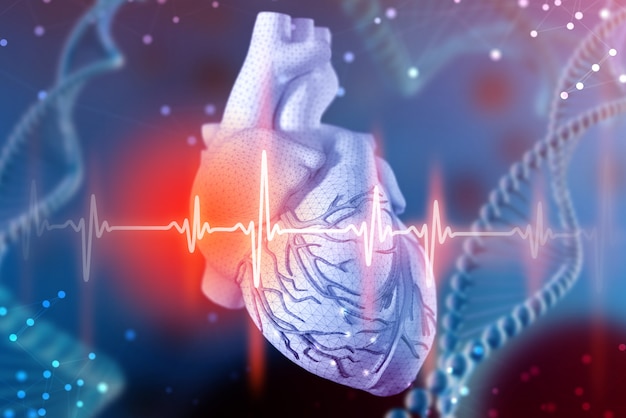HearthStats: Unveiling the Latest in Heart Health Innovations and News

The human heart, that tireless engine of life, remains at the forefront of medical innovation and public health concern. With cardiovascular diseases (CVDs) persistently ranking as a leading global cause of mortality, staying abreast of groundbreaking research, technological advancements, and evolving lifestyle strategies is paramount. HearthStats serves as your vital conduit to the most compelling and transformative developments in cardiology, preventive care, and patient empowerment. This article delves into the critical trends, revolutionary technologies, and foundational lifestyle shifts defining the current landscape of heart health, translating complex data into actionable insights for both individuals and communities committed to fostering cardiovascular resilience and longevity.
The Escalating Burden of Cardiovascular Diseases: Global Statistics and Alarming Trends
The sheer scale of cardiovascular disease prevalence presents a sobering global health challenge. According to the World Health Organization and leading cardiology associations, CVDs claim approximately 17.9 million lives annually, accounting for an estimated 32% of all global deaths. This burden is not distributed equally; significant disparities exist based on geography, socioeconomic status, and access to healthcare. Low- and middle-income countries bear a disproportionate share, often grappling with limited resources for prevention and treatment. Within developed nations, concerning trends like rising rates of hypertension in younger adults and the persistent impact of obesity and type 2 diabetes on heart health underscore the complex interplay of modern lifestyles and cardiovascular risk. The economic impact is staggering, costing global economies hundreds of billions annually in healthcare expenditures and lost productivity. Understanding these statistics and trends is not merely an academic exercise; it fuels targeted public health initiatives, resource allocation, and the urgent drive for innovative solutions to curb this escalating epidemic.
Breakthroughs in Diagnostic Technologies: Pioneering Early and Precise Detection
The adage “prevention is better than cure” rings especially true in cardiology, and cutting-edge diagnostic technologies are revolutionizing our ability to identify heart disease earlier and with unprecedented precision. Advanced imaging modalities like high-resolution cardiac CT angiography and 4D flow MRI provide exquisitely detailed views of coronary arteries, blood flow patterns, and heart muscle function, often detecting subtle abnormalities long before symptoms manifest. Beyond imaging, the field of liquid biopsy is making waves, with researchers developing highly sensitive blood tests capable of detecting minute levels of cardiac-specific biomarkers or even circulating endothelial cells shed from damaged blood vessel walls, signalling very early stages of atherosclerosis or impending events. Furthermore, genomic risk stratification is moving towards clinical reality, utilizing polygenic risk scores derived from large-scale genetic databases to identify individuals with an inherently high predisposition to conditions like coronary artery disease or cardiomyopathy, enabling proactive, personalized prevention strategies long before traditional risk factors emerge.
Revolutionizing Cardiac Interventions: Minimally Invasive Surgeries and Beyond
Gone are the days when open-heart surgery was the default solution for many cardiac conditions. The realm of minimally invasive surgeries and percutaneous interventions has expanded dramatically, offering patients shorter recovery times, reduced pain, and lower complication risks. Transcatheter Aortic Valve Replacement (TAVR) has become a standard, life-saving procedure for inoperable or high-risk patients with severe aortic stenosis, and its indications are rapidly expanding to include lower-risk populations. Similarly, MitraClip and other transcatheter edge-to-edge repair (TEER) devices provide hope for patients with mitral regurgitation deemed unsuitable for traditional surgery. The field of electrophysiology is equally dynamic, with pulsed field ablation (PFA) emerging as a potentially safer and more efficient method for treating atrial fibrillation by using targeted electric fields to isolate problematic heart tissue, minimizing damage to surrounding structures. Concurrently, bioresorbable vascular scaffolds (BVS), though undergoing refinement, represent a futuristic vision where stents dissolve after providing temporary support to healed arteries, restoring natural vessel function.
Wearable Technology and Remote Monitoring: Continuous Vigilance for Heart Health
The proliferation of sophisticated wearable technology has empowered individuals to become active participants in monitoring their cardiovascular well-being. Devices extending far beyond basic step counting now offer continuous electrocardiogram (ECG) recording (like Apple Watch and certain Fitbit models), detecting atrial fibrillation with increasing accuracy. Advanced photoplethysmography (PPG) sensors track heart rate variability (HRV), a key indicator of autonomic nervous system balance and stress levels. More specialized medical-grade wearables, often prescribed for post-procedure monitoring or managing chronic conditions like heart failure, provide continuous data on metrics such as thoracic impedance (indicating fluid buildup) and detailed arrhythmia logs, transmitted seamlessly to healthcare providers. This paradigm of remote patient monitoring enables earlier detection of decompensation in heart failure patients, allows for real-time medication adjustments, reduces unnecessary hospital visits, and provides invaluable longitudinal data for personalized care plans, fundamentally shifting management from reactive to proactive.
Nutritional Science and Lifestyle Medicine: Cornerstones of Sustainable Prevention
While technology advances, the bedrock of heart health remains nutritional science and comprehensive lifestyle medicine. Research continues to refine our understanding of optimal dietary patterns, with strong evidence solidifying the benefits of whole-food, plant-predominant approaches like the Mediterranean, DASH, and Portfolio diets. These patterns, rich in fruits, vegetables, whole grains, legumes, nuts, seeds, and healthy fats (especially omega-3s), consistently demonstrate powerful effects on lowering LDL cholesterol, blood pressure, inflammation, and overall CVD risk. Beyond specific diets, the critical importance of sustained physical activity – encompassing both regular aerobic exercise and strength training – cannot be overstated, improving endothelial function, cardiac output, and metabolic health. Equally vital is the growing recognition of psychosocial factors: chronic stress, social isolation, depression, and poor sleep quality are now firmly established as independent and modifiable risk factors for heart disease. Integrative lifestyle interventions addressing diet, movement, stress management (through mindfulness, yoga, or therapy), sleep hygiene, and social connection form the most potent, evidence-based strategy for preventing the onset and progression of cardiovascular disease.
Artificial Intelligence and Machine Learning: Reshaping Cardiology’s Future
Artificial Intelligence (AI) and Machine Learning (ML) are rapidly transitioning from futuristic concepts to practical tools transforming cardiology. AI algorithms are achieving superhuman performance in analyzing complex medical images, detecting subtle signs of disease on echocardiograms, cardiac MRIs, and coronary angiograms faster and sometimes more accurately than the human eye. Machine learning models are being trained on vast electronic health record datasets to predict individual patient risk for events like heart attack or stroke with remarkable precision, incorporating a multitude of variables beyond traditional risk scores. Natural Language Processing (NLP) is being used to extract critical information from unstructured physician notes, enhancing patient phenotyping and research data collection. Furthermore, AI is accelerating drug discovery by identifying novel therapeutic targets and optimizing clinical trial design. As these technologies mature, they promise to enhance diagnostic accuracy, personalize treatment pathways, streamline workflows, and ultimately improve patient outcomes on an unprecedented scale, ushering in a new era of data-driven, precision cardiology.
Conclusion
The landscape of heart health is one of dynamic tension between persistent challenges and extraordinary innovation. While the global burden of cardiovascular disease remains immense, the convergence of advanced diagnostics, minimally invasive treatments, empowering wearable technologies, proven lifestyle strategies, and the transformative potential of AI offers genuine hope. HearthStats illuminates this evolving frontier, translating complex data and groundbreaking research into accessible knowledge. True progress, however, hinges on the integration of these advancements into equitable healthcare systems and the daily choices of individuals. By embracing evidence-based prevention, leveraging technological tools for vigilance, and advocating for accessible, cutting-edge care, we can collectively shift the trajectory towards a future where cardiovascular disease is not a leading killer, but a manageable condition, allowing more hearts to beat strong and long.
Frequently Asked Questions (FAQs)
1. What are the most significant modifiable risk factors for heart disease?
The most critical risk factors you can actively change include smoking (and vaping), uncontrolled high blood pressure, high LDL (“bad”) cholesterol, diabetes or prediabetes, obesity (particularly abdominal obesity), physical inactivity, an unhealthy diet (high in processed foods, saturated/trans fats, salt, and sugar), chronic stress, excessive alcohol consumption, and poor sleep quality. Addressing these through lifestyle changes and medical management is the cornerstone of prevention.
2. How accurate are consumer wearables (like smartwatches) at detecting heart problems like AFib?
Consumer wearables with ECG functionality (e.g., Apple Watch, certain Fitbits, Samsung Galaxy Watch) have shown good accuracy in detecting atrial fibrillation (AFib) when symptoms are present or when the user initiates a reading. However, they are screening tools, not diagnostic medical devices. They can produce false positives (indicating AFib when it’s not present) and false negatives (missing AFib). Continuous PPG-based detection is less specific. Any irregular rhythm notification should always be followed up with a healthcare professional for confirmation using validated medical equipment like a 12-lead ECG or Holter monitor.
3. Is TAVR now better than open-heart surgery for aortic valve replacement?
TAVR is a revolutionary procedure and is now the preferred option for most patients with severe symptomatic aortic stenosis who are at low, intermediate, or high surgical risk. For patients in their 80s or 90s, or those with significant comorbidities making open-heart surgery too risky, TAVR is often life-saving. For younger, lower-risk patients, the choice between TAVR and surgical aortic valve replacement (SAVR) involves careful consideration by a heart team. Factors include patient age, anatomy, life expectancy, desired lifestyle, and the potential need for future interventions (as long-term durability data for TAVR in young patients is still evolving). Both options have excellent outcomes in appropriate candidates.
4. Can you really reverse heart disease with diet and lifestyle changes?
Significant regression, or reversal, of atherosclerosis (plaque buildup in arteries) is possible, particularly in its earlier stages, through intensive lifestyle modification. Landmark studies like the Lifestyle Heart Trial demonstrated that a very low-fat, whole-food plant-based diet, combined with regular exercise, stress management, smoking cessation, and group support, could shrink coronary plaque without medications. While such intensive reversal is most documented with aggressive protocols, substantial stabilization of plaque and dramatic reduction in risk of heart attack and stroke are consistently achievable through sustained healthy lifestyle changes, often complemented by necessary medications. It requires significant commitment but is powerful medicine.
5. How is AI actually being used by my cardiologist right now?
While fully autonomous AI diagnosis isn’t standard yet, AI tools are increasingly integrated into clinical workflows:
-
Image Analysis: AI assists in measuring heart function (ejection fraction) from echocardiograms or MRIs, quantifying plaque burden on CT scans, and flagging potential abnormalities for closer review.
-
Risk Prediction: Algorithms analyze your EHR data (labs, vitals, history) to generate more personalized risk scores for future events.
-
ECG Interpretation: AI helps rapidly analyze ECGs, prioritizing abnormal findings for the cardiologist’s attention.
-
Clinical Decision Support: Systems can alert doctors to potential drug interactions or guideline-recommended treatments based on your specific data.
-
Administrative Tasks: AI aids in transcribing notes and streamlining documentation. Your cardiologist is likely using AI as a sophisticated assistant to enhance accuracy and efficiency.

